Mossman, Queensland, is located 75 kilometres north of Cairns and 10 kilometres from Port Douglas and close to the world-famous Daintree National Park, which can be found to the west of the town.
The Kuku Yalanji People
The Kuku Yalanji people (Kubirri-Warral) who belong to the Bama Rainforest Peoples, inhabited the Daintree region exclusively before European settlement, living as hunting and gatherers. Many Aboriginal people still speak the native language of their ancestors and share Dreamtime stories, from a time that they call
Ngujakura.
The Kuku Yalanji language, which is spoken in the area between Mossman and Cooktown in North Queensland, is a living language. Dyirbal-speakers to the south were mostly regarded as enemies. However, there were at least 60 clans in the rainforest tropics
of the region and much diversity.
The Bama
Rainforest People are notable for their rich material culture. They made large
wooden shields and swords, the cross boomerang, giant stone axes and bark blankets.
Interestingly, the Kuku Yalanji people would detoxify cycad seeds, for eating. These seeds are a source of carbohydrates, but they contain a toxic substance called cycasin which can cause nausea and vomiting and also damage the nervous system. One method of detoxification was to cut open the seed and leach out the toxins in water.
During the wet season, some of the Bama people would mummify their dead. And sometimes, relatives would carry the body around as they moved about until the body was cremated.
According to the
Mossman George Centre, Manjal Dimbi is the most prominent of all nearby mountains. Roughly translated, Manjal Dimbi means "mountain holding back". According to Aboriginal Dreamtime stories, the large humanoid rock represents Kubirri, who came to the aid of the Kuku Yalanji when they were persecuted by the evil spirit, Wurrumbu. Kubirri holds back the evil spirit, who is now confined to The Bluff above Mossman River, Manjal Dimbi has been anglicised to "Mt Demi" and Kubirri is known as the "Good Shepherd.”
 |
| Aboriginal life in Queensland, "conveying news". Sydney Mail and New South Wales Advertiser (NSW : 1871 - 1912), Saturday 13 October 190 |
 |
| Aboriginal mia mia, Far North QLD, Leader (Melbourne, Vic. : 1862 - 1918, 1935), Saturday 13 August 1910 |
 |
| Two Aboriginal men, holding a boomerang, spear and a sword and shield, standing in front of two seated Aboriginal women and a child holding a dilly bag, Far North QLD, Kuku Yalanji (also known as Gugu Yalanji, Kuku Yalaja, and Kuku Yelandji) is an Australian Aboriginal language of the Mossman and Daintree areas of North Queensland. NLAUS |
 |
| Basket making by Aboriginal man, QLD, Leader (Melbourne, Vic. : 1862 - 1918, 1935), Saturday 13 August 1910 |
 |
| This type of grass-basket, worn by a Koko-yelandyi woman in the Mossman camp, is typical of this part of the eastern coast of North Queensland. The mouth is kept open by a stiff coil of lawyer-cane, whilst a piece of split cane is used to suspend the basket from the forehead. Art in Australia. Third series, No. 59 (15 May 1935) |
 |
| Kung'ga:ndyi man holding large fighting sword ( ba.go:r) and shield (b.go :rn). Design: scorpion (dumbun). Art in Australia. Third series, No. 59 (15 May 1935) |
Gold and Settlers
George Dalrymple, an explorer and politician, whilst on his final
expedition, explored Mossman and the Daintree Rivers in 1853.
Dalrymple, named Mossman River after Hugh Mosman, the miner who found gold at
Charters Towers, according to one story.
Another story states that the wife of Premier Palmer, a sister of Hugh Mosman, often spelt her maiden name with a double "s", and perhaps, Dalrymple was actually thinking about her when he spelt the name of the Mossman River with the double "s".
When gold was discovered at Charters Towers in 1872,
prospectors and settlers poured into North Queensland, looking for riches and opportunities. The resulting gold rush disrupted the lives that Aboriginal people had been living for thousands of years.
Timbers cutters began harvesting cedar from the Mossman River and Daintree River valley during the 1870s, resulting in hostilities between the Kuku Yalanji and the settlers. In 1878,
according to reports, Aboriginal people killed three cedar cutters on the Daintree River, resulting in the government sending the Native Police to the region.
 |
Native Police, Rockhampton, 1864, 1st Lieutenant George Murray (back row 2nd left) and his detachment of Native Mounted Police taken 1 December 1864 at Rockhampton. George Murray became Brisbane's Chief Police magistrate after his service in the NMP. Back Row: Trooper Carbine, 1st lt George Murray, 2nd Lieutenant unknown, Camp Sgt unknown, Corporal Michael. Front Row: Trooper Barney, Hector, Goondallie, Balantyne and Patrick.
|
Unfortunately, violent clashes occurred between the
Aboriginal people, the Europeans and Chinese, during the
land clearing periods. The Chinese had also extensively cleared land so that they could grow rice and other vegetables. In 1880, a Chinese camp was attacked by the Aboriginal people, and a man speared to death. The Native Police were sent to Mossman.
In October 1877, William Thomson applied for Selection No.28 at Mossman. This was the first homestead selection
applied for and taken up in the area. Thomson grew maize, coffee, coconut trees and mulberry. Thompson was murdered in October 1886. His wife Ellen became the only woman legally hanged in Queensland, for the crime, along with her lover John Harrison.
 |
| Record, description and criminal history of Ellen Thompson, 17 May 1887 Queensland State Archives, Digital Image ID 8657 |
Dan Hart
Jamaican cedar getter Dan Hart secured Homestead Selection No.35, which is now the western half of Mossman town, in 1878. He called his property “Coolshade” and grew vegetables and many tropical fruits. The settlement was initially named
Hartsville, after Dan Hart. Then the name
Thooleer came into use after a property located near the river port.
Dan Hart also donated
part of his land to the Anglican Church in 1898, and St David’s Anglican Church still exists on this land.
In 1878, the Police Commissioner noted that from Mulgrave to Mossman, “the natives were literally starving”.
Thomas William Wilson
established a property in 1879, on the eastern half of what is now Mossman town. He donated land for a school and sold some land for the sugar mill site.
A sawmill was established in Mossman in 1880.
William Henry Buchanan
established "Bonnie Doon", on the south bank of the Mossman River, in 1881.
By 1882, the cedar on the Mossman River was almost exhausted and the land was cleared to grow sugar cane.
Samuel Johnston became the owner of "Drumsara" (named after his place of birth), a sugar estate on the Mossman River in 1882. in the same year, John Pringle and wife Bridget established "Fairymount". Johnston leased land to the Chinese, where they grew crops.
 |
| A photo of Samuel Johnston Snr, circa 1890 |
Mango Park was established by John Dorrens Johnston, the brother of Samuel Johnston of Drumsara, in 1883.
 |
| John Dorrens Johnston (1837-1916) |
The "Brie Brie Sugar Plantation" and mill was established in Mossman in 1883, by Harriet Parker, who came to Mossman from Melbourne in the 1880s, contracted to a Brisbane jam factory. After only crushing for one or two seasons the mill went broke, due to mechanical issues and
financial problems.
The Brie Brie mill was inoperative by 1886, but Commissioner Hodgkinson toured Queensland’s sugar districts in the same year and decided that the
flat land around the Mossman River was very suitable for sugar processing.
 |
| Planting sugar cane on Brie Brie Estate, Mossman, Queensland, ca. 1925. Stay Library of QLD |
Mossman Central Mill Company Limited started life as a grower-owned co-operative sugar mill in 1894. The Muntz, Crawford and Watson families were involved in the development of the Brie Brie and Mossman’s sugar industry, since this time.
Richard Owen Jones and his wife, Mary Letitia Jones, were the selectors of "The Cedars", where they built the first rice mill. They also had 200 Chinese cultivating, rice, bananas and maize, on the land. Some of the obituary of Mrs Mary Letitia Jones illustrates something of the times in which they lived.
 |
| Cairns Post (Qld. : 1909 - 1954), Friday 28 July 1939 |
Violence Continues
The violence between settlers and Aboriginal people continued. In 1885, a small scale farmer on the Mossman River named Algernon Sydney Barnard was found dead with multiple spear wounds to his body. Again the native Police were sent
to the region.
"The murder is reported from Port Douglas of a selector named Algernon Sydney Barnard, who was speared by the blacks while engaged in felling scrub on his selection on the Mossman River. Deceased was a native of Melbourne, and had been a resident of Queensland for about two years. He was 23 years of age. This fresh outrage by the aboriginals adds further testimony to the great want of better police protection in this district."
Morning Bulletin (Rockhampton, Qld), 2 April 1885.
Daniel Hart wrote to the Premier in 1889, stating that the Europeans had taken all the land in the district, resulting in the Aboriginal people being forced to steal food to avoid starvation. And that reports to the police about the thefts by Aboriginals led to trackers and troopers dispersing Aboriginal people with bullets.
Aboriginal people who were not "dispersed" from the area were assimilated, sometimes working on sugar plantations around Mossman. Or removed into missions. The first mission was Bloomfield (1885), Mossman Gorge (1916) and Daintree River (1940. (Wet Tropics Management Authority, undated: 1-9).
 |
| Typical Queensland cane-cutters, Leader (Melbourne, Vic. : 1862 - 1918, 1935), Saturday 23 May 1908 |
In 1897, the Queensland Parliament passed the Aboriginal Protection and Restriction of the Sale of Opium Act 1897 (the Protection Act).
Some Settlers
Some settlers in the Mossman district, in the early days, included, Mr Pringle who established a property called “Fairymount” and William Buchanan whose farm was called “Ellendale”. On the northern side of Mossman River, R O Jones established “The Cedars”. He also rented land out to his Chinese labourers and “erected a rice husking mill at Port Douglas for his Chinese tenants and operated a sawmill in Mossman for 11 years” (Kerr: 14). William Thomson, “built a piggery and planted mulberry, Liberian coffee and coconut trees” (Kerr, 1995: 12) and John Crees selected land near Craiglie in 1880 and began a dairy farm on his property “Ferndale”, also growing fruit and maize. In 1883, John Dorrens Johnston established “Mango Park”, while his brother Samuel Johnston established “Drumsara”. Read more
Not So Sweet Labour
From the 1860s, tens of thousands of Pacific Islanders were brought to Australia as low-paid labourers. Some people were forcibly taken, in a process called "blackbirding", often by force and deception and put to work as cheap labour in the sugar industry.
The farming of sugar relied on indentured Melanesian, Chinese, Javanese and Malay labour. Aboriginal labourers
were also used on some plantations, including the “Vilele” plantation near Bloomfield River and “Drumsara” in Mossman (Kerr, 1995).
 |
| Australian South Sea Islanders at Mossman, Queensland, circa 1895. State Library of Queensland |
The Pacific Island Labourers Act 1901, however, resulted in the deportation of approximately 7,500 Pacific Islanders. There were various grounds for exemption from deportation, including marriage to an Australian.
 |
| Sugar cane cutters in Mossman, North Queensland - 1907, Aussie~mobs |
The Bump
Teamsters going to Mossman from Port Douglas would camp at the base of the range at Four Mile (as Craiglie was then known) before tackling "The Bump", the road over the Douglas Ranges. A village formed at Four Mile to supply
services to the teamsters, such as hotels, a blacksmith, a saddlery, and a butcher shop.
The Bump Track was the only
road access to Port Douglas until a coast road (now the Captain Cook Highway) was built to Cairns in 1933.
 |
| The Bump, Mossman District, c.1920s-1930s, This very steep dirt road falls down the range and led to the establishment of Port Douglas. Queensland State Archives |
The Mossman Central Co-operative Mill was established in the mid-1890s under the provisions of the 1893 Sugar Works Guarantee Act.
The steam train service was originally owned and operated by the Mossman Sugar Mill to transport cane and later expanded.
 |
| Mill Street, Mossman. A loaded cane tram headed by the 'Mossman' locomotive, passing an empty outward-bound train with the 'Pioneer' locomotive in the Mossman Station yard. The men riding on the empty cane truck are farm labourers. One of the men riding nearer the engine is Mr Harry Pringle (Description supplied with photograph). The Queens Hotel, and a windmill, can be seen in the background. Circa 1900 |
 |
| Mossman, north Qld - very early 1900s, Aussie~mobs |
Five Hotels
Before long, Mossman had five hotels and numerous other businesses, such as Jack and Newell's general store and the Mossman Co-operative Butchering Company and churches.
 |
| M. A. Tyrell's two storied hotel, Mossman, QLD, North Queensland Register (Townsville, Qld. : 1892 - 1905), Wednesday 14 April 1897 |
 |
| Buildings from left, the Catholic presbytery, St Augustine's Church-School, (church upstairs, school downstairs) and the Convent of Mercy. The presbytery was opened on 11 December 1932. The combined Church-School building was opened 29 April 1934 and the Convent, later that year. State Library of Queensland, circa 1900 |
 |
| The Tram Station, Mossman, Qld - 1909, The name on the Exchange Hotel on the left is Kirwan's. The hotel in centre is the Queens Hotel. Aussie~mobs |
 |
Intersection in the town of Mossman, Queensland, circa 1910
Postcard of the intersection of Mill and Front Streets at Mossman, around 1910, with the Exchange Hotel on the right. Back of postcard reads: "Sunday 30th July. Dear Minnie, These are the only views I could get. The little bit of Front Street you can see is the Chinese side. We live on the other side further up. This hotel is on the corner of both streets. Our street is very dark in the nights. I got a new hat and shoes for Anne last Friday. On Saturday night we went to the pictures and after we bought 5 hot pies and took them home to eat and it rained all the way home. Tell Joy there is a registered letter for her this mail. I am posting it on Tuesday. Goodbye for this time. K. D. Jones." Mill Street is the street lined with telegraph poles in the centre, and Front Street runs in front of the hotel. |
 |
| MOSMAN, WHtCH WAS DEVASTATED BY THE SAME CYCLONE ON 16th MARCH. Week (Brisbane, Qld. : 1876 - 1934), Friday 24 March 1911 |
 |
| Petersen's Mossman Hotel, 1911, Mossman, QLD |

Mossman School of Arts building, Douglas Shire, Queensland, n.d. State Library of Queensland
Italians
 |
| Mossman Central Sugar Mill Company of Queensland are importing 50 Italian labourers to work as -agricultural and general labourers on the sugar plantations of farmers who are growing cane for the company. Telegraph (Brisbane, Qld. : 1872 - 1947), Friday 9 November 1906, |
Bubonic Plague!
 |
| Daily Telegraph (Sydney, NSW : 1883 - 1930), Wednesday 23 January 1907 |
The Town Suffers a Blow
Two cyclones hit the town in 1911, causing immense damage to infrastructure and affecting the town's prosperity. Later, Mossman’s Anglican Church was rebuilt using stone, which has a better chance of withstanding extreme weather events.
 |
Lunn's Hall, Mossman, QLD, after the 1911 cyclone Lunn's Hall after the cyclone
|
 |
| Remnants of the Mill Kitchen at Mossman, Queensland, after the 1911 cyclone |
Rebuilding
 |
Buildings on Front Street, Mossman, QLD, including the Mossman and Royal Hotels, ca. 1912
|
 |
| Mossman, Queensland, early 1900s. Public Domain |
 |
| Tommy Kum Yuen was the largest Chinese sugar cane planter in the Mossman, QLD, district. He ran a store with his wife Lum See, in Mossman between 1914 and 1923 |
 |
| Ladies in unidentified railway carriage Mossman, Qld [n.d.] Special Collections |
Aboriginal Reserve
In 1916 an Aboriginal Reserve was created at Mossman Gorge, on 64 acres of land, donated by a cane farmer named Jack Johnston of "Mango Park Estate".
More info
 |
| Group of people at the Mossman Gorge Mission, 1950s http://www.slq.qld.gov.au/home/cop |
A Big Fish!
 |
| Weighing in of a 315 pound groper, 7 feet and 3 inches long, caught near the old wharf on the Mossman River. Included in the image are Jack Hides Jnr, Dick Ziegler, Bill Jones and Bill Harper (Description supplied with photograph). State Library of Queensland |
The Town's First Car
 |
First car in Mossman, Queensland, decorated for the 1919 Victory Parade
|
 |
| Northern Herald (Cairns, Qld. : 1913 - 1939), Wednesday 30 October 1929 |
1920s
 |
| Dick (Richard) Lunn's garage in Mill Street, Mossman, c1920, State Library of Queensland |
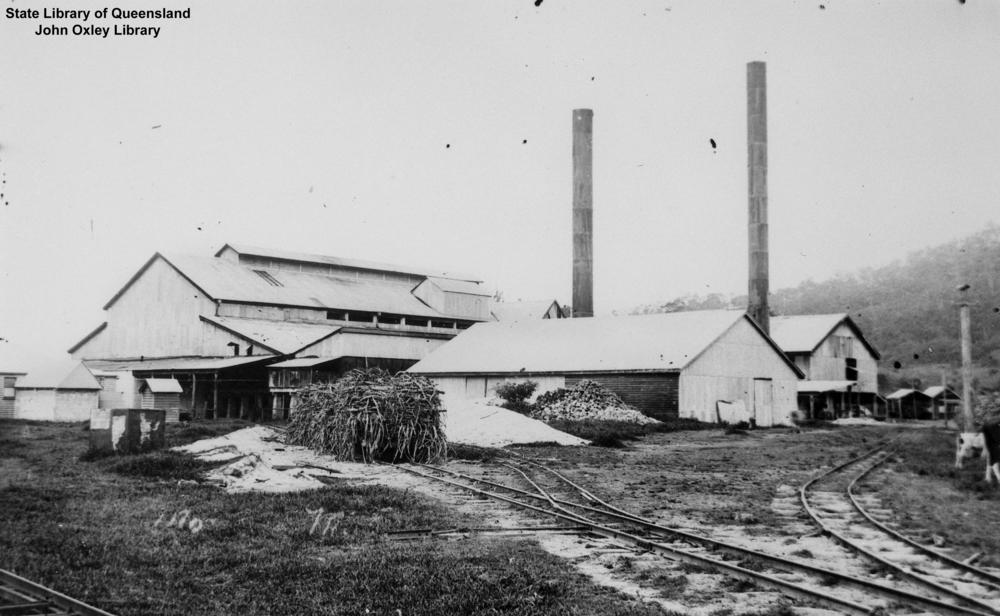 |
| Mossman Sugar Mill, Queensland, 1920s |
 |
Men and staff standing in front of the butcher's shop at Mossman, QLD, in the 1920
|
1930s
 |
| The "Port Douglas Express" leaving Mossman, QLD, Queenslander (Brisbane, Qld. : 1866 - 1939), Thursday 23 January 1930 |
 |
Sugar Cane Russell River, Mossman, QLD, c.1920s-1940s, Queensland State Archives. A motor spirit distilled from the sugar cane is claimed by a group of Brazilian sugar manufacturers to be more efficient than petrol. This fuel, known as Azulina, which is basically a mixture of ether and alcohol derived from cane sugar, has been in use for some time, in the State of Pernambuco. It is claimed that it will yield 10 per cent more mileage and 10 per cent more power than ordinary petrol, and that it can be produced at about 35 per cent less than the cost of imported petrol. CAIRNS POST
|
 |
| Jensen's Motor Service bus offering passengers the daily route between Cairns, Port Douglas and Mossman, QLD - circa 1933. (SLQLD) |
 |
| View of Mossman, Queensland, taken from the New Exchange Hotel, ca. 1935, SLQLD |
 |
| The premises of Jack & Newell, Mossman, which also suffered damage. Mossman QLD, Worker (Brisbane, Qld. : 1890 - 1955), Wednesday 4 April 1934, |
Floods
 |
| Two men standing calf-deep in the floodwaters in Mill Street, Mossman, during the 1934 floods. A larger group of people are gathered on the veranda of the Exchange Hotel. SLQLD |
The Hospital and The Theatre
The wonderful Spanish Mission style Mossman Hospital was built in the 1830s, the patients under the care of the capable Matron Cross.

Mossman Hospital, QLD, Telegraph (Brisbane, Qld. : 1872 - 1947), Saturday 17 December 1938
St Augustine’s school and convent were built around the same time period. The Lunn family contributed
to the town with various businesses, such as the Post Office Hotel and Photoplay Picture Theatre. The Photoplay Company was established by Richard "Dick" Lunn, the owner of the Coronation Hall, and a local photographer named, Ernest Hannaford.
 |
| Cairns Post (Qld. : 1909 - 1954), Friday 23 October 1936 |
 |
The Photoplay Theatre taken in the mid-1930s, Mossman, QLD
|
More 1930s
 |
| Mossman, Queensland, 1930s |
1940s
 |
| Cars travelling along Mill Street, Mossman, QLD, 1940. P.D. |
 |
| Mossman, QLD, 1940s-50s |
 |
| WAWOOAMITTAN ?'King of Woora,' who came from Mossman, 50 miles north of Cairns, to greet the Queen. With him came his family of 11 sons and three daughters. Here he holds his young son, Paddy, on his shoulders. His other children lined up behind him in the main street.Daily Advertiser (Wagga Wagga, NSW : 1911 - 1954), Tuesday 16 March 1954 |
WWII

MOSSMAN, QLD. 1944-01-22. MEMBERS OF THE LIGHT HORSE PLATOON OF E COMPANY 17TH BATTALION VOLUNTEER DEFENCE CORPS LINED UP ON THE EDGE OF A COCONUT PLANTATION. LEFT TO RIGHT: Q219666 LIEUTENANT W. H. CRAWFORD; Q219678 CORPORAL (CPL) T. KERSWELL; Q219725 LANCE CPL G. A. PALMER; Q219700 CPL A. M. BLAIN; Q219663 PRIVATE (PTE) N. BUCHANAN; PTE E. PALMER; Q219731 PTE J. PYE. AWM
 |
| MOSSMAN, QLD. 1944-01-24. THE SECOND IN CHARGE OF E COMPANY, 17TH BATTALION VOLUNTEER DEFENCE CORPS INSPECTING TORRES STRAIT ISLANDER MEMBERS OF THE UNIT. LEFT TO RIGHT: Q219685 LIEUTENANT A. J. MORGAN; Q219728 PRIVATE D. PITT; Q219716 PRIVATE P. JOSE; Q219698 PRIVATE W. AH WONG (AWM 063700) |
Bombed
On the night of 31 July 1942, a Japanese pilot dropped
eight bombs on Mossman, thinking that it was
Cairns. Seven bombs were
never recovered, while one fell on a sugar cane farm near Saltwater, Mossman, causing a crater that measured 7 metres wide and a metre deep. Shrapnel flew through the window of the nearby farmhouse and injured a sleeping child, who thankfully survived.
 |
| Horsham Times (Vic. : 1882 - 1954), Tuesday 4 August 1942 |
 |
| Sub Lieutenant Kiyoshi Mizukura who raided Townsville, Queensland twice and Mossman once, in his Emily flying boat in July 1942, while he was a trainee pilot. |
1950s
 |
| Post Office, Mossman, QLD, Townsville Daily Bulletin (Qld. : 1907 - 1954), Thursday 20 December 1951 |
 |
| The Daintree River Mission near Mossman, was run by the Assemblies of God. It opened in 1941 and closed in 1962. Brisbane Telegraph (Qld. : 1948 - 1954), Thursday 10 April 1952 |
1960s
1970s
Pat O' Shane was born at Mossman to an Irish father and Kunjandi mother. In 1976, she became the first Aboriginal Australian woman barrister and the first woman to head a State government department in Australia.
Around Mossman
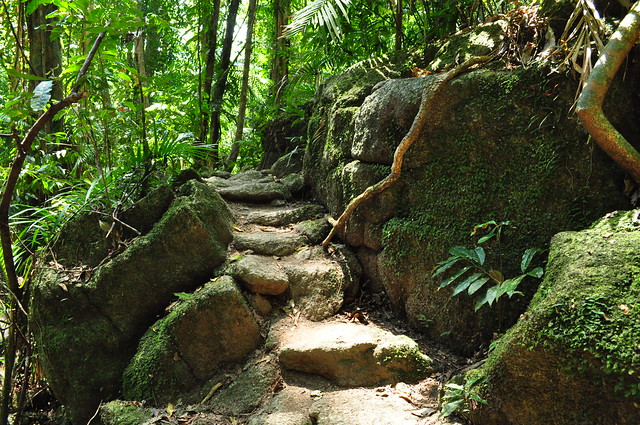 |
| Mossman Gorge. QLD, Sal |
 |
| Mossman Hospital built 1930s. Mossman, QLD |
 |
| The Exchange Hotel, 2 Front Street, Mossman, Far North Queensland, Australia. Circa 1896 |
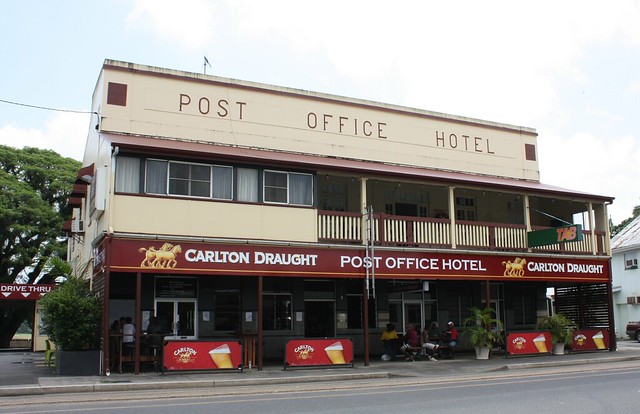 |
| Post Office Hotel, Mossman, QLD, circa 1909 |
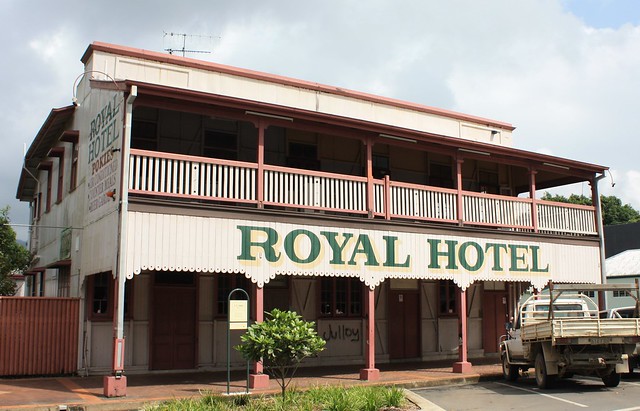 |
| The former Royal Hotel, Mossman, was damaged by a suspicious fire in 2011, built 1930s. Jan Smith |
 |
| Mossman Shire Hall, circa 1837 |
_(2009).jpg) |
| Former National Bank of Australasia Building built from 1935 to 1936, Mossman QLD |
 |
| Mossman Mill, QLD, circa 1894 |
 |
| The sugar Train making its journey past the Exchange Hotel, Mossman, QLD |
 |
| St David's Anglican Church, Mossman, constructed in three stages between 1912 and 1952 |
 |
| Queenslander in Mossman, QLD |
 |
| Johnston Road, Mossman, QLD |
 |
| The story of St David's Church, Mossman, QLD |
 |
| Mossman Gorge, QLD |
 |
| Art Deco building, Mossman, QLD, c1927 |
 |
| The Port Douglas, Queensland National Bank moved to Mossman, QLD, in 1927, to become the Queensland Ambulance Transport Brigade building |
 |
| Queenslander, Mossman, QLD |
Things To Do and Places To Go





































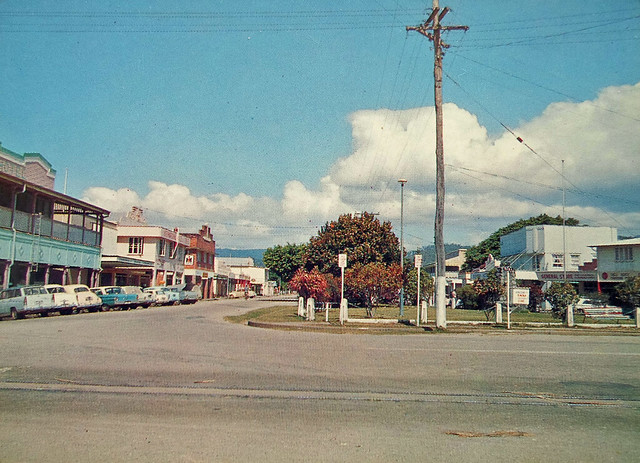





_(2009).jpg)



































